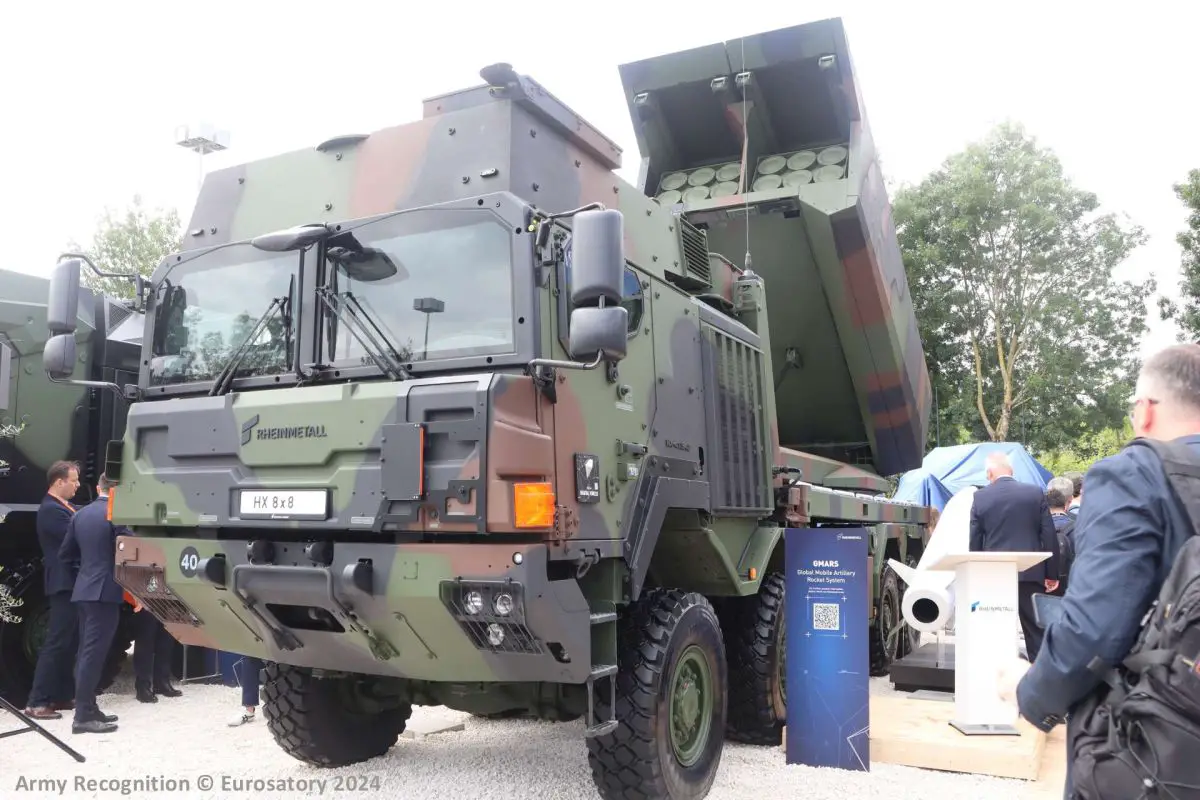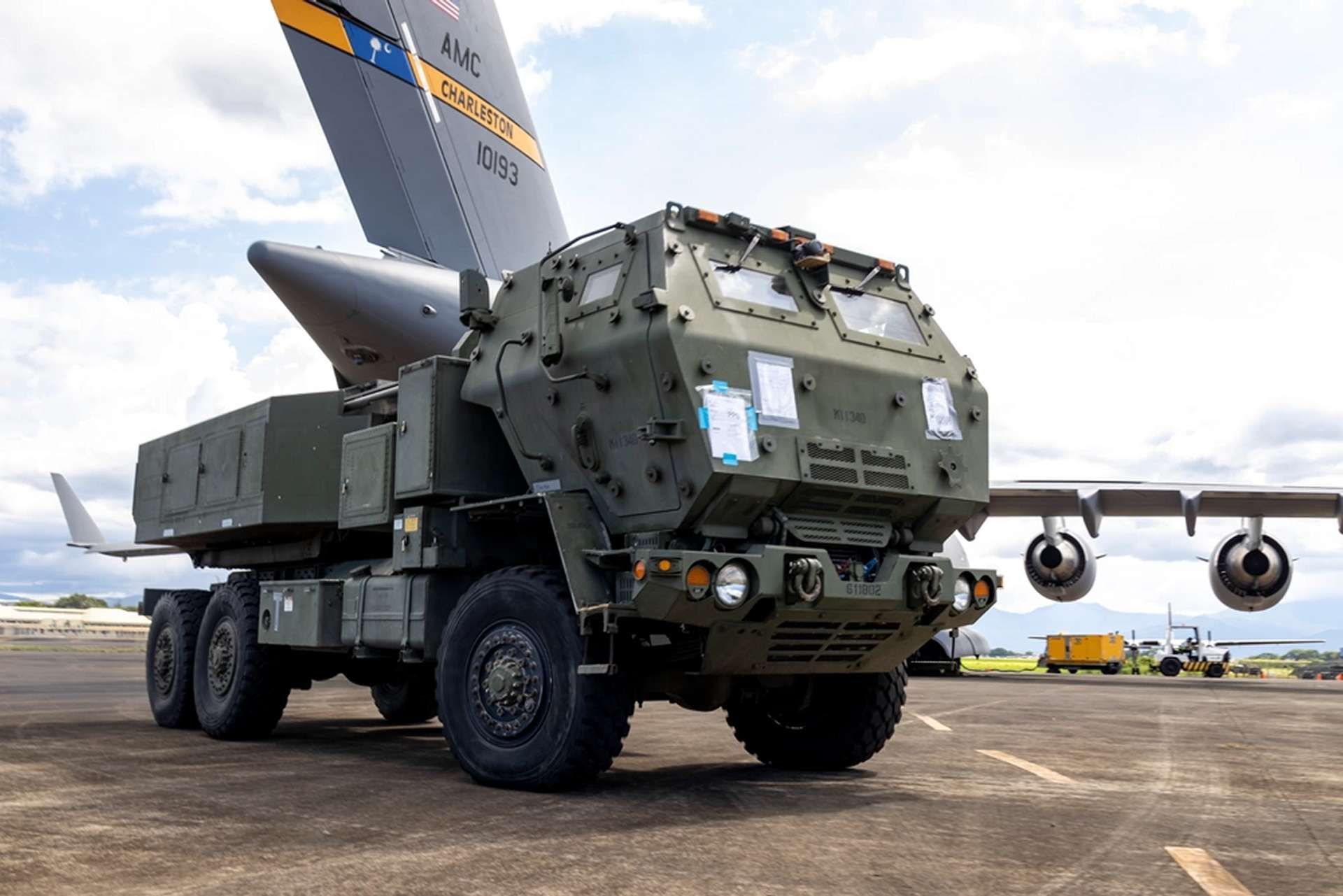Breaking news
Eurosatory 2024: Rheinmetall and Lockheed Martin's GMARS MLRS steps up as European competitor to M142 HIMARS.
On June 17, 2024, at the Eurosatory 2024 exhibition, the German company Rheinmetall and the American company Lockheed Martin jointly unveiled their Global Mobile Artillery Rocket System (GMARS). The GMARS project aims to replace Germany's MARS 2 systems, combining HIMARS technology with Rheinmetall’s HX 8x8 chassis to support NATO interoperability and firepower capabilities.
Follow Army Recognition on Google News at this link

The Global Mobile Artillery Rocket System (GMARS) is a joint development by Lockheed Martin and Rheinmetall, launched in 2023 to replace Germany's aging MARS 2 systems and create a European-based alternative to Lockheed's M142 High Mobility Artillery Rocket System (HIMARS). (Picture source: Army Recognition)
The Global Mobile Artillery Rocket System (GMARS) is a joint development by Lockheed Martin and Rheinmetall, launched in 2023 to replace Germany's aging MARS 2 systems and create a European-based alternative to Lockheed's M142 High Mobility Artillery Rocket System (HIMARS). The GMARS combines the HIMARS technology with Rheinmetall’s larger HX 8x8 chassis, allowing it to carry two rocket pods instead of one. This system is designed to ensure about 80% commonality with HIMARS munitions and logistics, maintaining interoperability within NATO forces, with the first GMARS units expected to be operational by 2025.
The GMARS is a multiple rocket launcher system capable of providing fire support missions up to a range of 400 km, with provisions for future enhancements to achieve even greater ranges. The system is designed to operate in all weather conditions, 24/7, ensuring reliable and precise long-range fires. The integration of the Multiple Launch Rocket System (MLRS) Family of Munitions (MFOM) within the GMARS enables it to achieve long ranges and high precision, enhancing its role in modern artillery units.
This multiple launch rocket system (MLRS) features a "shoot and scoot" capability that allows for rapid movement and quick deployment, allowing it to reposition quickly after firing to avoid counter-battery fire. It is operated by a minimal crew of two, with a cabin capacity of three, ensuring a small operational footprint. The system does not require outriggers for stabilization, enabling faster deployment and repositioning. The system's rapid emplacement capability is facilitated by a boom and hoist system that enables safe and quick reloading in all weather conditions.
The known technical specifications of the GMARS include a length of 9.8 meters, a width of 2.5 meters, and a stowed height of 3.9 meters. It has an empty weight of 31,140 kilograms, which reaches 42,240 kg when fully loaded for combat duty. The system can reach a maximum speed of up to 100 kilometers per hour and has an operational range of up to 700 kilometers under nominal conditions, which surpasses the M142 HIMARS's operational range and speed limits.

While both the HIMARS and the GMARS systems are designed for mobility and precision, the GMARS features an enhanced two-pod launcher system, allowing for greater payload capacity and a wider variety of munitions. (Picture source: US DoD)
The system is built with the flexibility to address a wide range of operational scenarios, from traditional artillery roles to advanced, multi-domain operations. Equipped with inertial navigation and GPS-aided targeting, providing high precision in both short and long-range engagements, this new system is designed to provide essential support to armed forces by targeting both pre-planned and time-sensitive objectives.
While both the HIMARS and the GMARS systems are designed for mobility and precision, the GMARS features an enhanced two-pod launcher system, like the EuroPULS system, allowing for greater payload capacity and a wider variety of munitions. These include the GMLRS (Guided Multiple Launch Rocket System) rocket with a range of over 70 kilometers, the ER GMLRS (Extended Range GMLRS) with a range of 150 kilometers, and the ATACMS (Army Tactical Missile System) capable of striking targets up to 300 kilometers away. The GMARS could also launch up to four PrSM (Precision Strike Missile), which offers a range of over 400 kilometers, providing deep strike capabilities. Additionally, a surface-launch cruise missile with a range of over 370 kilometers adds strategic targeting capabilities, while a 122 mm rocket provides a shorter-range option with a 22-kilometer reach.
The GMARS is designed for interoperability with NATO forces using M270 MLRS and HIMARS systems. It also features component commonality with the M270/HIMARS and Rheinmetall's HX Series of Mobility Platforms, ensuring logistical efficiency and operational readiness. The system supports pre-planned and time-sensitive targeting, making it suitable for multi-domain operations. Rheinmetall's 8x8 truck, serving as the platform for the GMARS, combines the ability to cover long distances with logistical commonality to the HX family in service with the German Army, including UTF and WLS.


























